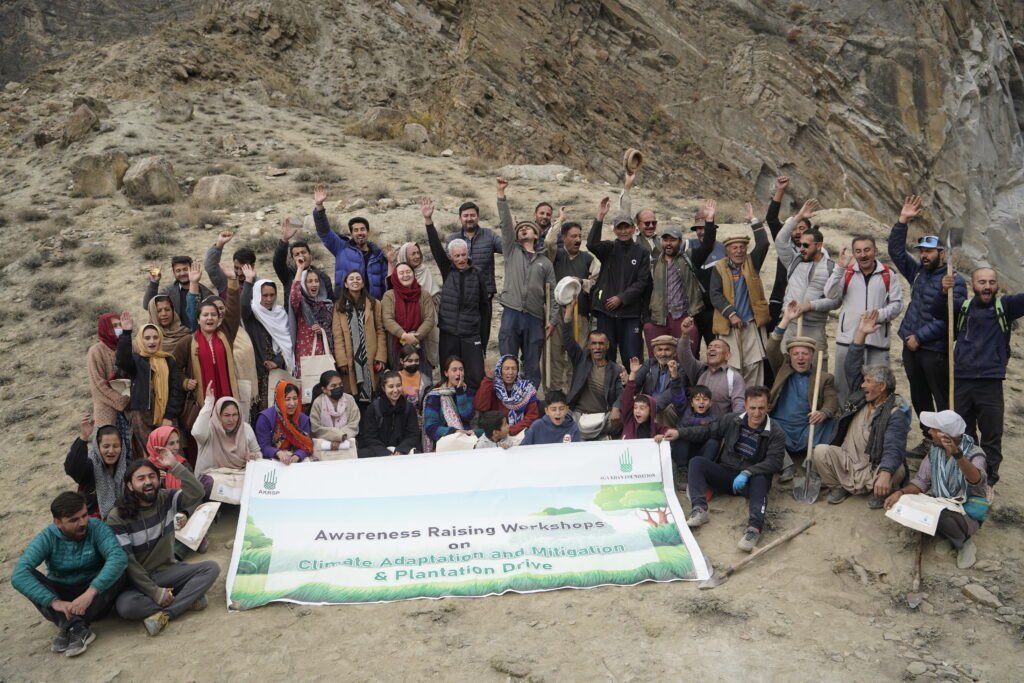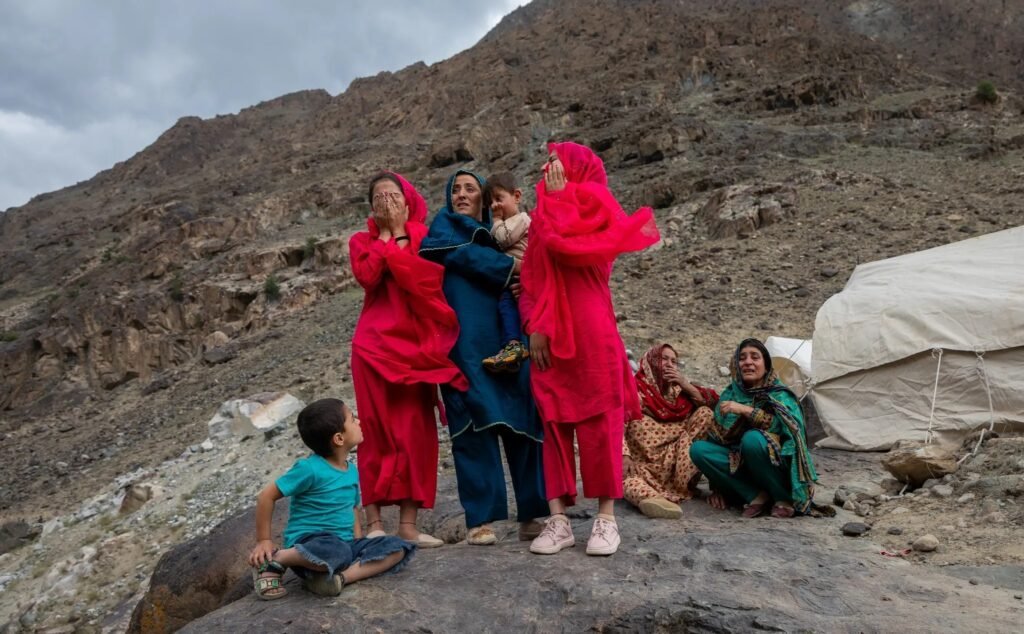KEY POINTS
- August 2025 floods submerged villages, destroying homes and livelihoods.
- Shepherds’ early warnings saved nearly 300 lives in Raushan.
- 41 dead, 1,253 homes damaged in Gilgit-Baltistan floods.
- Women in relief camps face acute privacy and health issues.
- Pakistan loses around 11,000 hectares of forest each year.
- Deforestation accelerates glacier melt and worsens devastating floods.
- Community-driven reforestation offers income, resilience, and environmental protection.
- Forests are Gilgit-Baltistan’s first defence against climate catastrophe.
GILGIT, Pakistan: Located in the northwest of Ghakuch city of Ghizer district in Pakistan’ northern Gilgit-Baltistan region, the remote Bubur village offers the tourists fascinating scenes of snow-fed streams cut through narrow terraces and jagged peaks rise like guardians of the valley.
Amid this breathtaking landscape, life here still revolves around the quiet rhythm of the land and its people. Raja Iqbal Hussain bends over a sapling with the care of a father tending his child.
Nature’s fragile balance
Ten years ago, this land was nothing but sun-baked stone and barren dust. Today, a forest of 16,000 trees rises where there was once only silence—a testament to beating the odds.
“I thought this land would never give me anything,” Hussain says, running his hand along the pale bark of a poplar.
“Now it gives us fodder for our animals, wood for our homes, shade for our children, protection from floods—and even helps slow the melting of our glaciers by keeping the air cooler.”
His words carry an urgency that reflects the valley’s new reality. In August 2025, Ghizer district was struck by a series of cloud bursts and glacial lake outburst floods (GLOFs).
Water surged down the mountainsides with violent force, submerging villages like Taalidas, Raushan, and Thingi and other surrounding villages in Gupis.
Entire fields were swallowed, homes reduced to rubble and many others submerged in the lake formed due to the blockage of the river, leaving thousands caught between a rock and a hard place.
I thought this land would never give me anything. Now it gives us fodder for our animals, wood for our homes, shade for our children, protection from floods—and even helps slow the melting of our glaciers by keeping the air cooler.” – Raja Iqbal Hussain
In the wee hours of 3:40 am, the day disaster struck, high above Raushan village, Wasiat Khan, a young shepherd, felt the earth tremble. “It wasn’t rain,” he recalls, his voice still raw. “It was the mountain itself, breaking.”
Together with two fellow shepherds, he raised the alarm, phoning villagers in the dark. Nearly 300 lives were saved by their swift warnings—proving that every cloud has a silver lining, even in the darkest moments.
By dawn, Raushan lay underwater. Survivors watched helplessly as centuries of toil—stone houses, fruit orchards, livestock, even irrigation channels carved by hand—vanished within hours.
“I saw my entire life drown,” says Fatima Bibi, a mother of four from Taalidas village, Ghizer. “Those trees raised my children. Now I feel naked before the mountain.” It was the straw that broke the camel’s back, and yet she clings to hope.
A valley in mourning
Relief arrived swiftly but not without strain. The Pakistan Army, Gilgit-Baltistan Disaster Management Authority (GBDMA), Aga Khan Development Network (AKDN) and other non-governmental organisations mobilised tents, food supplies, and medical care.
Yet, as floodwaters carved a new lake and destroyed bridges, the limitations of official disaster preparedness became painfully clear.
By late August, the National Disaster Management Authority (NDMA) confirmed that in Gilgit-Baltistan alone, 41 people had died, 52 were injured, and over 1,253 homes were damaged. Of these, 773 were completely destroyed.
Nearly 20 kilometres of roads and 87 bridges collapsed, severing entire valleys from aid. Some 3,140 people remain in relief camps, many of them women and children, facing acute shortages of sanitation facilities.
“Women are suffering most,” says Mir Bahadur, a manager at an NGO Khubaid Foundation, who visited the makeshift camps. “There are barely any washrooms, privacy is non-existent, and health risks are rising daily.”
But beyond immediate loss, the floods also exposed something far more insidious—the decades of deforestation that left these valleys so vulnerable.
It wasn’t rain. It was the mountain itself, breaking.” – Wasiat Khan, a local shepherd
The camps are unbearable in the daytime heat and stifling at night,” says Hajat Begum, a resident of Taalidas now living in a tent. She gestures towards the barren stretch where the shelters have been set up. “The sky is clear, the sun is harsh, and there isn’t a single tree to give us shade.”
The cost of deforestation
When floodwaters roared through Diamer and parts of Khyber Pakhtunkhwa, video footage showed entire rafts of timber being carried downstream. To many observers, it was proof of how unchecked tree-cutting has worsened the scale of natural disasters.
Gilgit-Baltistan, once rich in forests, today has just 3.58 per cent forest cover, according to Gilgit-Baltistan’s Forest, Wildlife and Environment department.
The World Rainforests and Food and Agriculture Organisation data reveal that Pakistan lost about 33.2 per cent of its forest cover between 1990 and 2010 (around 840,000 hectares), Similarly, the World Wildlife Fund estimates that Pakistan is losing about 11,000 hectares of forest per year.
“This isn’t just about losing a physical barrier against floods,” explains Dr Zakir Hussain, chief conservator of G-B’s forests department.”
We are losing our natural climate regulators. Forests are massive carbon sinks, absorbing the carbon dioxide (CO₂) that is heating our planet and melting our glaciers. They also create their own cooler microclimates through shade and moisture. When we cut them down, we remove the very thing that can slow down the cycle of warming and melting.”
Yet logging—both legal and illegal—continues. The controversial “Diamer Forests Working Plan,” which allowed the sale of old and dead timber stockpiled in the district for decades, has divided opinion.
The plan was approved in 2019 but its implementation has not yet started. Gilgit-Baltistan Chief Minister Haji Gulbar Khan, who also comes from Diamer district, recently defended the plan, arguing that it was prepared by experts after extensive deliberations, taking into consideration all aspects and was made to check further deforestation in the region. Khan is stated to be one of the investors in the business.
I saw my entire life drown. Those trees raised my children. Now I feel naked before the mountain.” — Fatima Bibi, a resident of Ghizer
A senior official at the forest department informs WE News English that the working plan has although been approved, yet its implementation seems next to impossible given the unauthentic data that is as old as 15 years.
“There is no way to start the implementation. The data available in the forests department is too old to be used,’’ he says, requesting anonymity.
“The data of timber falls way short of the actual situation, it’s 20 years old and is redundant now…the dead wood could be more than 10 million cubic feet (cft),’’ he remarks.
For experts like Dr Zakir Hussain of the Gilgit-Baltistan Forest Department, the path forward is clear: “We must plant at scale, but also protect what little remains. Plantation targets must be community-owned. Without local buy-in, these efforts will fail.”
Cooling the raging glaciers
Despite grim statistics, there are glimmers of resilience. In Bubur, Raja Iqbal’s 55-kanal forest is more than a personal success; it is a community model.
With support from the Aga Khan Rural Support Programme (AKRSP), solar-powered lift irrigation was introduced, turning barren slopes into thriving woodland.
The sale of fodder alone has earned him over Rs. 500,000 annually. Buoyed by this encouraging return, he plans to plant 23,000 more trees next year.
“Each tree is a guard. Together, they make a forest strong enough to reduce glacier melting and face the floods,” Hussain maintains.
G-B Minister for Food Ghulam Muhammad says, “The mountains of Gilgit-Baltistan are changing before our eyes. With shrinking glaciers, thinning forests, and bare slopes, every community is more exposed to disasters.
Reforestation is a dual solution: it provides a physical shield against erosion and floods, while the trees actively work to cool the region and draw down carbon from the atmosphere, addressing the root cause of the problem.”
Each tree we plant is a small act of protection. It shields the soil, cools the air, and gives our glaciers a little more time. Without forests, floods come faster and hit harder. With them, communities have a chance to stand and rebuild, he contends.
Greening against disaster
Since its inception, AKRSP has facilitated the plantation of more than 51 million trees across Gilgit-Baltistan and Chitral. Between 2022 and 2025 alone, it planted 3.3 million trees, which, according to scientists, absorb an estimated 20,767 tonnes of CO₂.
This sequestration is a direct, local contribution to mitigating the global climate change that fuels the region’s disasters.

Community driven climate change awareness and afforestation drive by AKRSP in Karimabad Hunza.
Its strategy combines block plantations, Miyawaki forests, model orchards, and even madrasa-led greening campaigns. A religious seminary in Diamer planted 10,000 poplars, turning barren land into a green belt.
“Trees are no longer just a symbol of beauty,” says prof. Dr. Maisoor Ahmed of the Department of Animal Sciences at Karakoram International University. “They are now a multifunctional frontline defence against climate change.”
Signals from the hills
The floods have also reignited debate over the role of indigenous knowledge in disaster preparedness. Despite millions invested in early-warning technology, it was three shepherds with mobile phones who saved hundreds of lives in Roushan.
This isn’t just about losing a physical barrier against floods. We are losing our natural climate regulators.” – Dr Zakir Hussain, Chief Conservator, G-B Forests Department
“A simple shepherd did what expensive machinery could not,” says villager Muhammad Nabi of Taalidas. “Maybe it’s time we recognise local wisdom.”
Officials are now exploring community sentinel networks—locals trained and equipped to monitor weather changes, blending tradition with modern science.
From ruins to roots
For families like Fatima Bibi’s in Taalidas, rebuilding feels like starting from zero. Her neighbour Abdul Wahid points at his broken irrigation channel: “We build, the water takes it again. Without trees, we are helpless.”

The Taalidas disaster displaced hundreds of families now living in tents in harsh condition. Photo: Taseer Beyg
Yet in Bubur, the forest grown by Raja tells a different story.
The land that once yielded nothing now offers resilience, income, and pride. His success has inspired neighbouring farmers, who are now seeking saplings of their own.
“Forests will not stop floods. But they will reduce the damage, slow the water, sequester carbon, and regulate local temperatures—and give people time to act. In mountain valleys, that can be the difference between life and death,” Dr Zakir says.
Back among his trees, Raja looks out at the valley where floods still scar the earth. “These saplings won’t save me today but they will clean the air for my children and cool the valleys to protect our glaciers. That is enough reason to plant,” Raja says.
His forest is not just a patch of green on barren slopes; it is living proof that communities, when supported with the right tools, can turn disaster into resilience. The Aga Khan Rural Support Programme’s backing made his dream possible—a reminder that real change often begins in partnership with the people most at risk.
As experts warn of harsher GLOFs in the years ahead, the lesson is clear: forests are the first line of defence. If government and policymakers replicate community-driven models across Gilgit-Baltistan, empowering villages to plant and protect their own slopes, then what is today a fragile experiment could become tomorrow’s shield against climate catastrophe.
Read on the original source:: How Shepherds and Saplings Saved Lives in Pakistan’s Northern Areas




